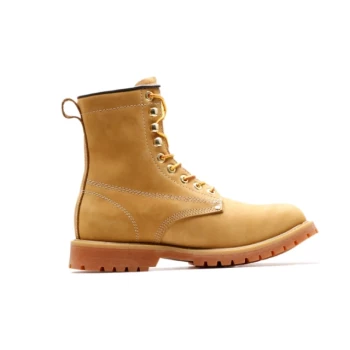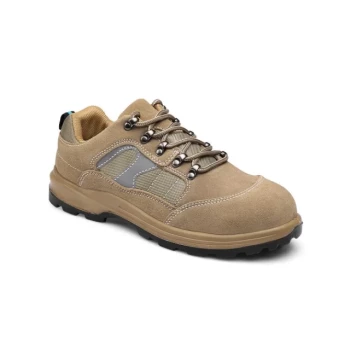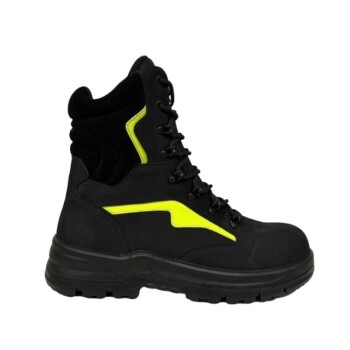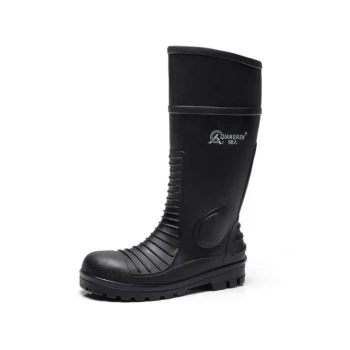Choosing the right pair of boots requires you to look beyond style and price. The most critical factors are the boot's intended purpose, the materials used in its construction, the level of support it provides, and how well it fits your specific foot.
The single most important principle is to match the boot to its mission. A boot is a specialized tool, and selecting the right one means clearly defining the job it needs to do, whether that's navigating a worksite, hiking a rugged trail, or walking city streets.
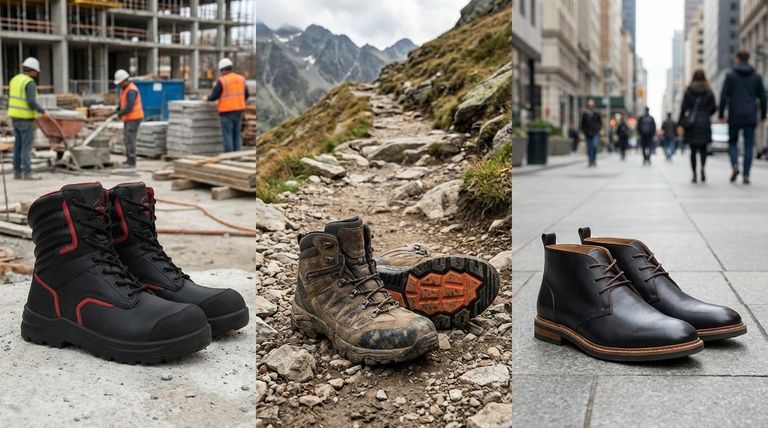
The Foundational Question: What is the Boot's Purpose?
Before examining any specific features, you must first define the primary environment and activities the boot will be used for. This context dictates every other choice.
For Everyday & Versatile Wear
For daily use in casual or business-casual settings, the focus is on a balance of style and comfort.
Versatile styles like the Chukka, Chelsea, or classic lace-up boots work well with a wide range of outfits. The key is quality material and a comfortable, supportive footbed for all-day wear on predictable surfaces like pavement.
For Hiking & Outdoor Pursuits
When walking on trails and uneven ground, function takes priority. The terrain and load you carry are the most important variables.
Boots with a higher ankle construction are essential for protecting against ankle twists on rough terrain, especially when carrying a pack. The outsole's grip and the boot's overall weight become critical factors for safety and endurance.
For Demanding Work Environments
In a work or job site setting, safety and durability are non-negotiable.
You must consider the specific hazards of your environment. This includes underfoot conditions like wet, muddy, or slippery surfaces and the need for specific safety features. Comfort is also crucial if you spend long hours standing on hard surfaces like concrete.
Decoding the Core Components of a Boot
Once you know the boot's purpose, you can evaluate its individual components to see if they meet the demands of that purpose.
Materials: The First Line of Defense
The material dictates the boot's durability, weather resistance, and breathability.
Full-grain leather offers maximum durability and can be made highly water-resistant, making it ideal for tough work or hiking boots. Synthetic fabrics, like Cordura, are often lighter and more breathable, suited for less demanding conditions or when weight is a primary concern.
Support & Height: From Ankle to Calf
Boot height is directly related to the level of protection and support required.
Lower-cut boots (6 inches or less) offer more flexibility and mobility, which is preferable for even ground or when agility is needed. Taller boots (8 inches or more) provide superior ankle support, which is vital for carrying heavy loads or navigating unstable ground.
Insulation & Warmth: Managing the Elements
Insulation is a critical feature for anyone wearing boots in cold temperatures.
For late-season hunts in the snow or work in frigid environments, insulated boots are necessary to retain warmth and prevent cold-related injuries. However, in warmer conditions, this same insulation will trap heat and sweat, causing significant discomfort.
The Outsole: Your Connection to the Ground
The outsole, or the bottom of the boot, determines its grip and stability.
The depth and pattern of the lugs (the bumps on the outsole) are designed for specific surfaces. Deep, aggressive lugs are built for mud and loose terrain, while softer, more flexible outsoles are better for gripping smooth, wet surfaces.
Understanding the Trade-offs
Choosing a boot always involves balancing competing features. Understanding these compromises is the key to making an intelligent decision.
Support vs. Flexibility
A tall, stiff hiking boot provides excellent ankle support, reducing the risk of injury on uneven trails. However, that same stiffness makes it heavier and less comfortable for casual walking on flat ground, where a flexible walking shoe would feel better.
Waterproofing vs. Breathability
A fully waterproof membrane is excellent for keeping your feet dry in wet or snowy conditions. The trade-off is reduced breathability, which can cause your feet to overheat and sweat excessively in hot, dry weather.
Durability vs. Weight
Heavy-duty leather work boots are built to withstand years of abuse, but they are also heavy. Lighter synthetic boots may be more comfortable for fast-paced activities but will not offer the same long-term durability or protection.
Making the Right Choice for Your Goal
Filter your options based on your primary need to find the boot that serves you best.
- If your primary focus is daily style and versatility: Prioritize quality materials like leather and classic styles (Chukka, Chelsea) that offer all-day comfort on flat surfaces.
- If your primary focus is trail hiking and backpacking: Prioritize ankle support, a grippy outsole designed for uneven terrain, and a proper fit to prevent blisters on long treks.
- If your primary focus is workplace safety and durability: Start by identifying the specific safety requirements for your job, then focus on durability and comfort for your specific work conditions.
By matching the boot's design to its intended function, you invest not just in footwear, but in comfort, safety, and performance for the task at hand.
Summary Table:
| Key Factor | Key Consideration | Ideal For |
|---|---|---|
| Purpose | Environment & Activity | Work, Hiking, Daily Wear |
| Materials | Durability & Weather Resistance | Full-grain leather, Synthetics |
| Support & Height | Ankle Protection & Stability | Low-cut (flexibility), High-cut (support) |
| Outsole | Grip & Traction | Deep lugs (trails), Flexible soles (pavement) |
| Key Trade-off | Compromise | Support vs. Flexibility, Waterproofing vs. Breathability |
Need the Perfect Boot for Your Specific Needs? Partner with 3515 Factory.
As a large-scale manufacturer, we produce a comprehensive range of footwear for distributors, brand owners, and bulk clients. Whether you need durable work boots for demanding job sites, high-performance hiking boots for rugged trails, or stylish boots for everyday wear, our production capabilities encompass all types of shoes and boots.
Let us help you deliver the right tool for the job. Contact our team today to discuss your requirements and discover how we can support your business with quality, reliable footwear.
Visual Guide
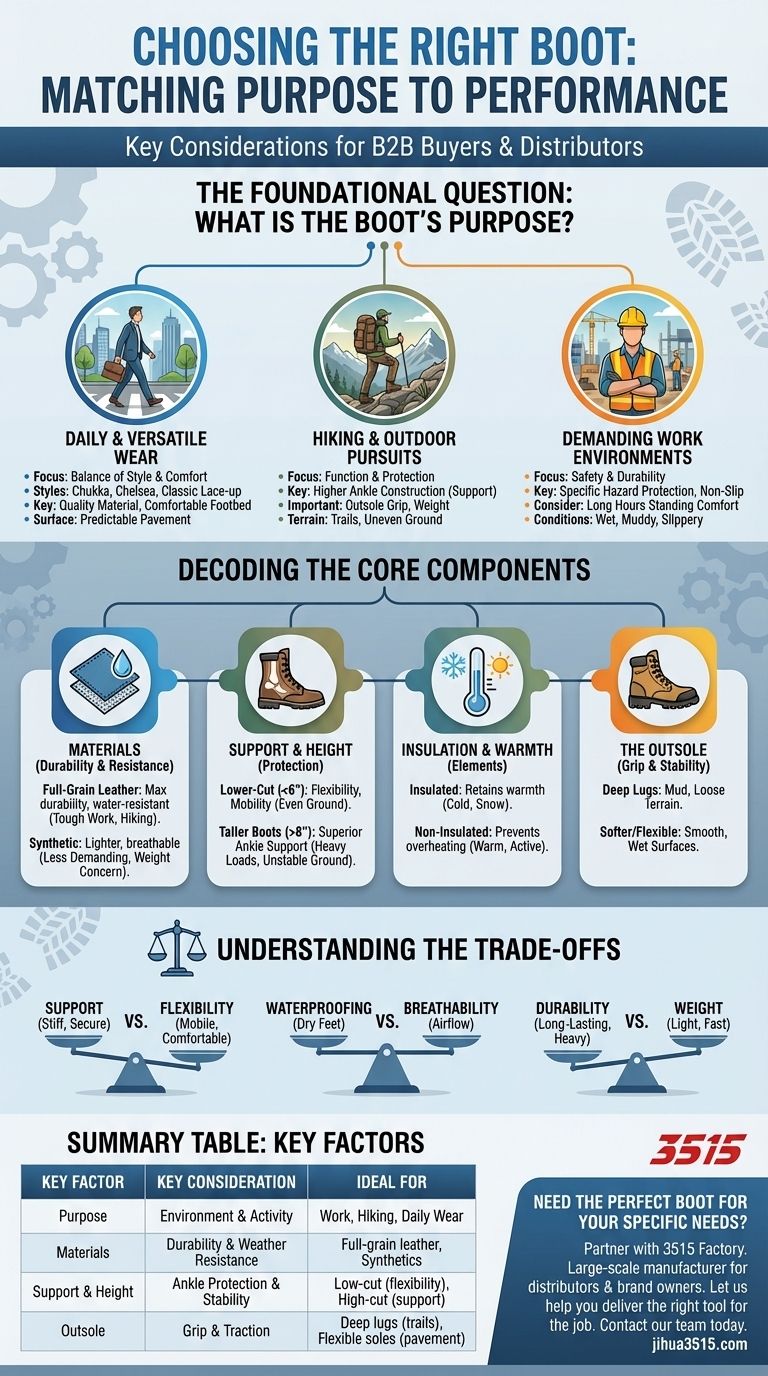
Related Products
- Premium Wholesale Waterproof Safety Boots High Performance Protection for Industrial Markets
- Customizable Anti-Smash Safety Boots for Wholesale & Private Label Manufacturing
- Premium Grain Leather Safety Boots for Bulk Supply
- Wholesale Durable Safety Boots Manufacturer Customizable Steel Toe Work Boots
- Wholesale Customizable Safety Boots Durable & Protective Footwear Manufacturing
People Also Ask
- What is the primary purpose of safety shoes? Your Ultimate Guide to Workplace Foot Protection
- What are some real-world examples of safety footwear preventing injuries? Protect Your Workforce Effectively
- What are some examples of footwear requirements in different work settings? Ensure Safety and Compliance
- What is the OSHA standard for safety-toe boots? Ensuring Compliance and Worker Protection
- How do safety shoes protect you? A Guide to Essential Footwear Safety Features





